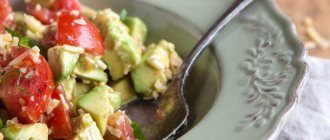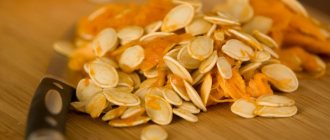Avocado, a strange fruit brought to our country from distant southern countries, is increasingly appearing on the shelves in vegetable departments. Avocados are actively used in cooking: they are added to various dishes and prepared as an independent product. The fruit has an interesting taste, so it is eaten both fresh and baked or fried. Let's figure out whether avocado is beneficial or harmful to the body, and find out how to eat it correctly.
Chemical composition and properties of avocado
Avocado (butter fruit, alligator pear) has a rich composition that has a beneficial effect on the human body.
The pulp of a fruit weighing 200 g contains the most of the daily requirement:
- vitamin K - 52%;
- folic acid - 40%;
- vitamin C - 34%;
- vitamin B5 - 28%;
- vitamin B6 - 26%;
- vitamin E - 20%;
- potassium - 28%
The composition also includes copper, magnesium, phosphorus, iron, zinc, omega-6, pantothenic and oleic acids. 100 g of pulp contains 27% of the daily fiber requirement.
Calorie content and BZHU
The calorie content and nutritional value of avocados depend on the variety. On average, 100 g of fresh product contains from 160 to 220 kcal, 20 g of fat, 2 g of protein and 6 g of carbohydrates.
Dietary recipes
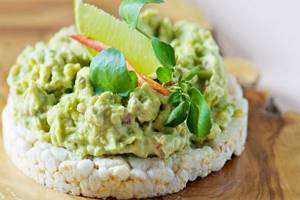
Because of the delicate taste of the pulp, the fruit is very popular with chefs, so it is added to almost any dish. Avocado is often included in meat and fish salads and is used for baking, stewing and frying vegetables with meat and fish. Then the dish can be served spectacularly: right in the empty boat left from under the fruit. Show your imagination, play with the recipe in your own way, add your favorite spices, and you will see that avocado is not only a healthy storehouse of vitamins, but also a tasty delicacy for those who love to eat.
Dietary avocado and shrimp salad
Avocado pulp goes best with the delicate taste of shrimp meat, so there are many interpretations of the salad. We suggest adding a little sourness to the dish - grapefruit, the benefits of the salad will only increase, and the taste will become slightly unusual and even a sophisticated gourmet will like it. 100 g of light salad produces only 120 kcal.
Compound:
- 1/2 grapefruit;
- ripe avocado - 1 pc.;
- 80-90 g peeled shrimp;
- a bunch of arugula;
- 1/2 part lime;
- a pinch of ground black pepper;
- olive oil for dressing - tbsp.
How to cook:
Wash the avocado, cut into 2 equal slices and remove the pit. Cut out the pulp with a knife, but do not touch the skin. The cup from the fruit will be needed to serve the salad; it must not be damaged. Cut the pulp into small cubes and place in a bowl.
Peel the grapefruit and remove the white film from the segments. Cut the slices into small pieces and place in a bowl.
Take the shrimp already boiled and peeled so that you don’t have to fuss with them. If you use king prawns in cooking, cut them into 3-4 pieces to make it easier to eat. There is no need to cut cocktail shrimp. Place the seafood in a bowl with the remaining ingredients.
Squeeze the lime juice into a cup, making sure that the seeds do not get into the salad with the juice. Tear the arugula into a bowl. Lightly drizzle the ingredients with olive oil, pepper and mix well again.
The salad can be served immediately after preparation, but it will taste better if you put it in the refrigerator for half an hour. To serve, take the remaining skin from the fruit. Place the salad in the boat; you need to fill it tightly, without fear that the boat will tear. The skin of the fruit is strong, so don’t be afraid to add more filling. Serve the boats and help yourself, bon appetit!
On a note!
Instead of arugula, you can take any other greens of your choice. Lettuce, basil, parsley, cilantro will do.
Chicken salad with avocado
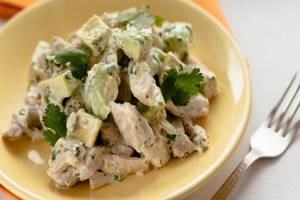
Chicken lovers will love this simple recipe for a light but very nutritious salad with the addition of cherry tomatoes and sweet pear pieces. This is a great option for a hearty snack for lunch or even dinner. One serving of salad contains no more than 140 kcal, so you don’t have to worry about your figure.
Compound:
- 1 PC. avocado;
- 120 g chicken breast;
- 6-7 Cherry tomatoes;
- sweet and sour pear – 1 pc.;
- lime wedges with lemon for garnish;
- according to tbsp. olive oil and soy sauce.
How to cook:
Place the chicken breast in a saucepan, cover with water and boil the meat until tender. Remove the cooled meat from the bones, remove the skin, and then cut the fillet into small pieces.
Wash the Cherry tomatoes and dry on a towel. Cut each tomato in half and add it to the chopped chicken fillet.
Divide the avocado into 2 parts, remove the pit. Remove the pulp from the fruit and cut into approximately the same pieces as the chicken meat, and then transfer to a bowl with the rest of the ingredients.
Wash the pear, remove the skin and cut out the core. Chop the fruit into cubes and place in a cup.
The salad is almost ready, all that remains is to season it with olive oil and soy sauce. Add your favorite spices to taste; Italian herbs, rosemary and basil work well. Before serving, garnish the dish with fresh lime and lemon wedges.
On a note!
Do not pour the broth left over from cooking chicken into the sink. Put it in the refrigerator and then cook a light soup.
Baked Avocado with Egg Sauce
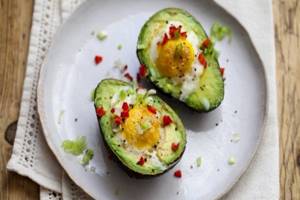
If you are watching your figure and sticking to a healthy diet, there is one very tasty recipe that you will surely enjoy. Vegetable casserole is perfect for lunch, but you can make it for breakfast. It takes about half an hour to prepare.
Compound:
- 3 ripe avocados;
- 2 tomatoes;
- 50 g cheese;
- a pair of chicken eggs;
- tsp lemon juice;
- tbsp olive oil;
- spices and salt to taste.
How to cook:
Place the cut avocado slices on a greased baking sheet and bake in the oven at 180 degrees for 20 minutes. Then remove the fruit from the oven and wait until it cools completely.
Cut the tomatoes into pieces; if the skin was too hard, it needs to be removed. Separate the yolks from the whites into a bowl; the whites will not be needed. Place the cup with the yolks in a water bath and beat them until they begin to thicken. Add spices and salt to the yolks, add lemon juice and stir again.
Scoop out the pulp from the cooled avocado slices with a spoon. In a baking dish, place pieces of fruit on a greased bottom. Place a layer of tomatoes on top and then pour in the egg mixture.
Grate the cheese on a fine grater, sprinkle it on the dish and place the baking dish in an oven preheated to 180 degrees. Cooking time is 10-15 minutes. As soon as a golden brown crust has formed on top of the casserole, turn off the heat - the dish is ready.
You should try the casserole while it is hot; if desired, sprinkle with fresh chopped herbs before serving for beauty.
The benefits and harms of avocados for women
Doctors and nutritionists unanimously recommend avocados for the prevention of many diseases. The nutritional value and composition of the fruit, rich in vitamins and microelements, make it possible to use avocados at any age and in any state of health.

Medicinal properties for various diseases
Thanks to the components that make up avocado, it has a healing effect on the body for various diseases:
- Vitamin K helps normalize the functioning of the kidneys and liver, participating in cleansing the body of toxins. In addition, it is responsible for the synthesis of platelets, maintaining blood clotting at a normal level. Avocado is the basis of the diet for hemophilia.
- Folic acid helps relieve nervous tension, strengthen the immune system and prevent the development of bacterial and viral diseases. Normalizes the functioning of the digestive organs and lungs, helping in the transport of oxygen to the organs. Reduces the risk of blood clots and helps achieve weight loss results by speeding up metabolism.
- Potassium strengthens the walls of blood vessels and controls the functioning of the cardiovascular system. According to the World Health Organization, regular consumption of avocados reduces the risk of heart attacks and strokes by 25%.
- Polyunsaturated fats, magnesium and saponins have a beneficial effect on bones, cartilage and joints. This occurs due to the strengthening of bone tissue and the normalization of metabolic processes in it. According to Brazilian scientists, this effect is long-term.
- Avocado is used in the treatment of skin diseases - it restores the natural lipid barrier of the epidermis.
- The high iron content is suitable for the treatment and prevention of anemia.
- Suitable for feeding people with diabetes, as it normalizes blood sugar levels.

Benefits for different ages
Avocado is an ideal product for women's health of all ages. The greatest value is a large amount of folic acid, which affects many vital processes of a woman’s body. Avocado is involved in the prevention of osteoporosis, which develops against the background of premenopause and menopause. The fruit slows down skin aging, the appearance of wrinkles and hair loss.
By maintaining sufficient levels of oxygen in the blood and internal organs, avocado fruits help minimize the effects of stress during menopause, improve the general condition of the body and increase performance.
Contraindications
The list of contraindications for use is small:
- individual intolerance;
- child under 2 years of age (may cause stomach upset);
- chronic or acute liver diseases;
- allergies to citrus fruits, birch pollen, and latex (this is explained by the similarity of the allergenic proteins of avocados and the rubber from which latex is made);
- tendency to diarrhea and other gastrointestinal disorders.

The pit and peel of an avocado can harm the human body - they should not be eaten. They contain toxic substances that can cause poisoning and gastrointestinal problems.
In what form and quantity to eat for maximum benefit?
To prevent avocado from losing its beneficial properties, nutritionists and doctors recommend consuming it fresh, for example, making a paste for sandwiches or adding it to a salad. However, you shouldn't get carried away.
The optimal dose for an adult is one medium-sized ripe fruit daily or every other day. In this case, the body will receive maximum benefit and will be able to absorb all trace elements and vitamins.
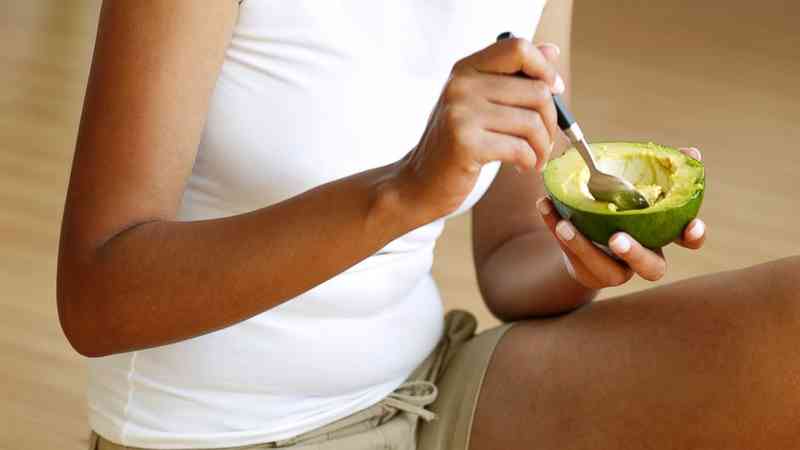
Contraindications
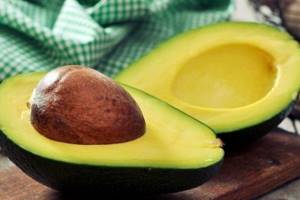
You should not try fruits for food if you have an individual intolerance or have previously been diagnosed with an allergic reaction to exotic fruits. Although an allergy to avocado is quite rare, its manifestations should not be ruled out. You should not eat fruits if you suffer from:
- irritable bowel syndrome;
- chronic gastrointestinal diseases;
- pain in the stomach area.
In other cases, there is no danger from eating a fresh ripe avocado. For a healthy person, the fruit brings only benefits and is completely safe to eat.
Avocado for women during pregnancy
During pregnancy, regular consumption of avocados will provide the woman’s body with essential microelements and vitamins:
- High folic acid content will help prevent fetal development defects. It also reduces the risk of developing pyelonephritis and maintains normal uterine tone, the strengthening of which becomes a common cause of miscarriage, especially in the early stages.
- Monounsaturated fats will help the placenta, brain and visual apparatus of the fetus to form correctly.
- Potassium normalizes the functioning of the heart of the pregnant woman and the fetus.
- Due to the stress on the body, pregnant women experience deterioration in vision. The carotenoids contained in the oily fruit will maintain visual acuity at the same level.
The optimal dose for a pregnant woman is half an average fetus every other day.
When breastfeeding
Pediatricians recommend introducing avocados into the diet of a nursing woman two months after giving birth. Avocado improves intestinal function and, due to its high iron content, prevents the development of anemia. At the same time, it will not harm the baby; on the contrary, it will soften the symptoms of colic in a newborn.
Fats and fiber for weight loss

Foods rich in fats or dietary fiber make you feel full after eating. This is because they slow down the movement of food from the stomach to the intestines, which makes us feel full longer, snack less between meals, and therefore consume fewer extra calories per day.
Avocados happen to be high in both fat and fiber, so they keep you full for a long time.
There is even a study on this topic (2), which says that if a person eats half a fruit for lunch, he does not feel like eating for the next almost 5 hours (the effect is stronger in the first 3 hours, then gradually fades away).
Participants felt 23% more full after eating a meal that included avocados compared to those without the fruit.
Beauty benefits
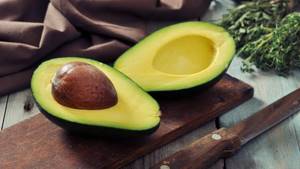
Avocados benefit more than just your internal organs. Its positive effect is also noticeable on a woman’s appearance.
For hair
Vitamins and microelements in the “alligator pear” strengthen follicles, reducing hair loss and premature thinning. The roots receive more nutrients, which has a positive effect on hair growth and thickness.
For skin
Vitamin K, folic acid and B vitamins make the skin elastic and moisturized. Expression and age wrinkles are smoothed out, the natural oiliness of the skin is normalized.
Important! For long-lasting and effective results, it is not enough to just eat avocados. It is worth paying attention to cosmetic products, for example, shampoos and masks, with avocado squeeze.
For weight loss

Despite its high calorie content, it can and should be consumed during a diet. The high content of L-carnitine activates fat synthesis, which is actively involved in lipid metabolism, which is responsible for energy. That is, the substance acts as a conductor, accelerating the movement of fatty acids in the metabolic process. Penetrating into cellular mitochondria, acids are burned and converted into energy reserves.
Avocado promotes rapid digestion of proteins, thereby reducing the load on the kidneys. It also neutralizes bad cholesterol and promotes the production of natural insulin, normalizing metabolism. And thanks to the nutritional value of the fruit, you can reduce your serving size.
Indications for eating avocado
The medicinal properties of avocados are relevant for various diseases. The use of the fruit and its oil for preventive purposes is widespread. Let's consider the main indications for use:

- heart disease;
- diabetes;
- gout;
- weak immunity;
- pancreatitis and other gastrointestinal diseases;
- avitaminosis;
- swelling;
- cancer prevention.

It is enough to eat just one fruit a day. Overeating will lead to weight gain due to the fat content and high calorie content of the fetus.
For women…
The valuable properties of the fruit for women include preserving youth and protecting against breast cancer. It is recommended to include the fetus even in the menu of expectant mothers. Avocado supports the normal course of pregnancy and has a variety of beneficial effects on the condition of mother and child.
- Preventing birth defects. Avocado is a natural source of folic acid, which contributes to normal fetal development.
- Formation of a healthy immune system. The abundance of vitamins, microelements and other useful substances contributes to a good weight gain of the child after birth and forms a strong immune system.
- Increased skin elasticity. Due to beneficial acids, skin elasticity increases - less stretch marks are formed.
You should not eat too much fruit while breastfeeding. Avocado increases the fat content of milk - the baby may experience diarrhea.
We recommend reading: What kind of bulgur grain is it, how is it useful and possible harm
...and for men
Avocado is an essential fruit for men. It has a good effect on the reproductive system and is considered a natural aphrodisiac. For men, avocado is recommended in three cases.
- Treatment of impotence and infertility. Avocado extract is often added to medications to combat these problems.
- Building muscle mass. The fruit contains plant proteins that promote faster muscle mass gain with regular exercise.
- Prevention of heart disease. Due to the high potassium content, the likelihood of developing a heart attack is reduced and blood pressure is normalized.
Application in cosmetology
The rich composition of avocado has led to the widespread use of its oil and pulp in modern cosmetology. An extract from it is added to shampoos, masks and creams.
Reference. Avocado fatty acids have a similar composition to those that make up the lipid membrane of human skin.

Such “kinship” with the help of a mask allows you to maintain skin tone, restoring its elasticity and youth.
The components that make up the pulp also play a huge role:
- vitamin A triggers active cell regeneration;
- fatty acids “repair” holes in the lipid barrier of the epidermis;
- linoleic acid (omega-6) regulates the natural oiliness of the skin;
- vitamin E, a natural antioxidant, protects the skin from phytoaging and smoothes wrinkles;
- vitamin C, niacin and riboflavin inhibit natural aging by nourishing and moisturizing cells; vitamin C also lightens age spots.
You can test the cosmetic power of avocado with a simple mask. For it you need to grind some avocado pulp and half a ripe banana in a blender. Apply the resulting homogeneous puree to previously cleansed facial skin, hold for 20 minutes, and then rinse with warm water. This mask is suitable for any skin type and has a softening, nourishing and moisturizing effect.
To restore hair follicles, saturate them with useful substances, and give hair natural shine and smoothness, you can prepare a homemade conditioning balm. Grind half an avocado in a blender and mix with regular yogurt to the consistency of thick sour cream. The resulting mass is applied to the roots and distributed along the entire length of the hair with soft massage movements. Keep the balm for 30-40 minutes and then wash off with shampoo. To improve the therapeutic effect, the hair can be wrapped in film and a towel.
Use in cooking
Only ripe fruits are used in cooking - unripe ones have a dense consistency and do not have a special taste or smell. Avocado pulp is added to salads, sauces and sandwich pastes are made from it. It goes well with herbs, proteins, sour fruits, any vegetables, and red fish.
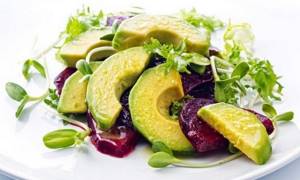
To clean it, cut it with a knife to the bone, carefully turn it, and divide it into two halves. Ripe pulp is removed with a spoon, dense pulp is cut with a knife. To prevent it from darkening, immediately sprinkle generously with lemon juice. Judging by the reviews, vegetarians appreciate avocados because of the abundance of protein. The fruit replaces meat, milk and eggs.
How to choose and store correctly
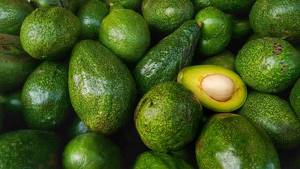
When choosing an avocado, be guided by the color of the skin and the softness of the fruit. The bright green color of the peel indicates immaturity; choose dark green fruits, without signs of mechanical damage or black spots (characteristic of overripeness). When choosing an avocado, press it lightly. A suitable fruit should be slightly pressed, while maintaining elasticity. An overripe avocado has pockets of air between the flesh and the skin, called “air pockets.”
Ripe avocados should be stored in the refrigerator for 3-5 days. To increase this period by 2-3 days, wrap the fruits in film or paper. However, when dark spots first appear, avocado must be consumed so that it does not have time to spoil.
A cut avocado quickly oxidizes in air and darkens. Place unused half in a container with a lid or cover with cling film. In this form, the product can be stored for no more than a day.
Attention! If you bought an unripe fruit, put it in a paper bag with a banana or apple and put it in a dark place. Check your avocados regularly. Once it becomes soft, it can be eaten. In this case, the refrigerator is prohibited, since low temperatures will slow down the ripening process.
Overripe fruit can be saved using the freezer. Grind the pulp in a blender and place in a container or bag. Avocados can be stored in this form for up to six months, adding puree to smoothies or homemade sauces.

Harm

Although avocado is considered one of the healthiest fruits, it can also cause harm, but only if consumed incorrectly or overeated. This manifests itself in the occurrence of:
- constipation;
- diarrhea;
- cramps in the abdominal area;
- gas formation;
- other problems related to the functioning of the digestive organs.
The above problems only appear if you eat several fruits every day for a long period of time. The digestive system malfunctions and, as a result, troubles arise. To avoid problems, nutritionists recommend not to get carried away with eating green pulp and limit your consumption of fruit to 1-2 pieces per day.
Interesting!
An adult fruit that has reached maturity weighs approximately 180-250 g.
Proper cutting of avocado
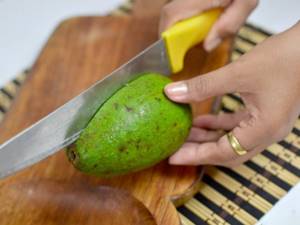
At first glance, cutting an avocado may seem like a rather complicated process. But in reality there is nothing complicated here. To do this, you only need a sharp knife.
Perform the following processes one by one:
- Take the avocado in your left hand and the knife in your right hand;
- Run the knife along the entire radius of the fruit so as to lightly touch the seed;
- Place the knife and hold the avocado with both hands so that there is a separated part in each palm;
- Rotate the halves 360 degrees and disconnect them from each other;
- There should be a bone left in one of the halves, which can be easily pulled out with a light blow with the tip of the heel of a knife;
- Carefully remove the skin from each half.
If you did everything correctly, then you should have two even halves of the peeled fruit. You can cook a huge number of delicious dishes with them.
Guacamole recipe
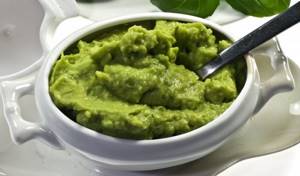
Guacamole sauce
Guacamole is a Mexican sauce that goes well with any dish.
To prepare it we will need the following set of products:
- Avocado 3 pieces;
- Chili pepper 1 pod;
- Tomatoes 2 pieces;
- Onion 1 head;
- Cilantro 1 bunch;
- Lime 1 piece;
- Garlic 1 clove;
- Salt to taste.
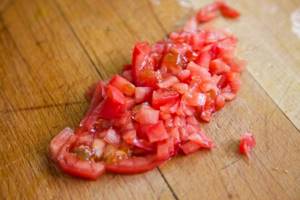
First, take tomatoes. They need to be blanched and finely chopped.

The chili pepper pod must be removed from the seeds and finely chopped.
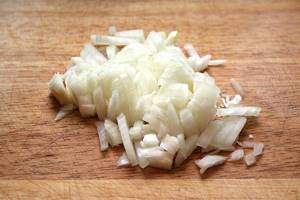
Now take the onion and chop it into small cubes.

Take a lime and remove a small portion of the zest from it.

Next, chop the garlic and cilantro leaves a little.
Now you need to take all the ingredients except the avocado. Place them in a blender and process each other a little. Add salt and lime juice to taste. Monitor the liquid state of the sauce. It shouldn't resemble a salad, but it shouldn't taste like soup either. Catch the average state.
It's time to get busy with the avocados. We have already learned how to cut it correctly, so there shouldn’t be any problems. Cut it into small cubes and add to the sauce.
Guacamole can be served with chips or lightly toasted bread. Bon appetit!
Sandwiches
Another dish that every housewife should write down in her cookbook. This is a very tasty, satisfying, healthy and, most importantly, quick to prepare snack. Avocado toast can be served not only for breakfast, but also on the holiday table.
- 3 cloves of garlic;
- two avocados;
- toaster bread;
- parsley;
- salt;
- lemon juice.
Experienced chefs say that the most important thing in such recipes is the right choice of avocado. Cooking methods may vary. The main thing is that the fruit is ripe and tasty. It is recommended to prepare the dish immediately before serving, since upon contact with air the pulp will quickly darken and lose its presentable appearance.
Slice the toasted bread. Line a large baking sheet with parchment paper. Lay out bread circles or squares. Dry them slightly in the oven. The sandwich base can also be prepared in a toaster or in a dry frying pan.
Peel, core and chop the avocado. Place the pulp in a blender and add parsley, garlic, lemon juice and salt. Beat the ingredients until smooth. Spread the resulting paste onto the toast and garnish each piece with a parsley leaf on top.

Beneficial features
The number of varieties exceeds 400 species. The yield of one tree is 150-250 kg. The shape of the fruit is pear-shaped, oval or spherical, weight up to 1.5 kg, length – ~10 cm. The skin is hard, dark green, the flesh is of a delicate consistency, oily, greenish-yellow in color.
There is a large seed in the center of the fruit. There are numerous debates on the topic of avocado - is it a fruit or a vegetable? Biologists believe that it is a fruit, but the taste is vaguely reminiscent of a nut-vegetable.
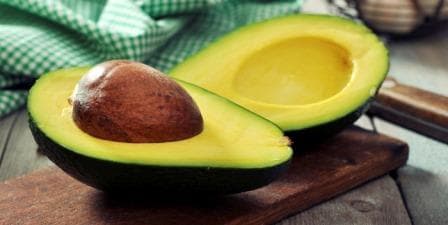
There are quite a lot of useful substances contained in avocados. So, it contains a number of vitamins: provitamin A, C, group B, PP, D, phylloquinone K, tocopherol (beta, gamma, delta), biotin, carotene, choline, betaine.
As for minerals, there are also plenty of them here. These are calcium, silicon, magnesium, sodium, sulfur, phosphorus, chlorine, boron, aluminum, iron, iodine, manganese, copper, fluorine, zinc, etc.
The nut-vegetable boasts a record content of potassium and vitamin E. In addition, it contains natural hormones, proteins, amino acids, fats and sterols. The fruit is very nutritious and high in calories.
100 grams of it contain 160 calories. At the same time, it does not contain sugar and harmful fats, so it is included in the diet menu.
But in order for the body to receive all of the above substances, first of all, the product must be chosen correctly. If you do not plan to consume the fruit immediately, it is better to purchase it hard.
It will ripen within 2 days in the room. Ripe fruit can be stored in the refrigerator for no more than 5 days, after which it darkens and loses its freshness and aroma.
What are the benefits of avocado and how to eat it?
Before you learn how to eat an avocado, you should know how to choose one. When purchasing, carefully inspect the peel. There should be no damage on it, the skin should be clean without cracks or stains.
Dark plaques are a sign of overripeness. By pressing your finger on the ripe ideal product, it will be slightly dented, but it should not be loose. There should be no rotting at the junction of the stalk.
Avocados are usually consumed raw. The fruit is cut around the seed, both halves are twisted in different directions, separating them. Use a spoon to remove the pit and peel off the skin.
Video about beneficial properties
But since the pulp quickly darkens in air, there is no need to peel the fruit in advance. They combine the fruit with many foods (red fish, shrimp, poultry), add it to salads and cold appetizers, prepare sauces, sweet and spicy seasonings. The most popular dish is the traditional Mexican sauce “guacamole”.
It is served with bread, corn chips and complements other dishes. The fruit adds a delicate taste and freshness to all dishes.
Interesting articles on this topic:
Useful properties of persimmon
Useful properties of ginger
The healing properties of pumpkin
Pomegranate, health benefits and harm
How to eat
It is recommended to eat only soft and ripe fruits. You cannot leave a cut avocado in the air for a long time, as it will darken and oxidize. To maintain a beautiful appearance and pleasant taste, you can sprinkle a slice of avocado with lemon juice. Currently, the fruit can be found in the cuisines of many countries. Each nation has its own understanding of how avocado is eaten and what benefits it has, as well as what dishes can be prepared from it to surprise guests. But before you prepare the product, you need to select and cut it correctly.
History of the origin of avocado

Mexico is considered the ancestor of avocados - the first mentions in the 4th-3rd centuries BC were there. A thousand years ago, indigenous Mexicans ate the fruit. With the beginning of the era of agriculture, residents began to grow the plant themselves - this is evidenced by excavations.
At first, people did not understand what was unusual about this plant - a small fruit with very little pulp and a large seed. But in the writings of the Aztecs, avocados were described in detail as a means of attracting the opposite sex. Indigenous Mexicans not only consumed the fruit - they learned to extract oil from it and use it for medicinal, cosmetic (sun protection) and culinary purposes.
The name of the fruit was first pronounced by Henry Sloan in 1669, and in 1697 American journalists began to use the name. During the era of great discoveries, the Spaniards became acquainted with Mexican culture, including local plants. At first, travelers did not like the vegetable, but later they learned the healing secrets of this exotic fruit from the Aztecs. The Spaniards generously shared their useful find with other European countries.
In the Middle Ages, it gained particular popularity in the Canaries and the West Indies. Avocado was mentioned in fragments in the notes of travelers even before the 17th century, for example, Martin Fernandez described this tree in 1518, and in 1519 Hernan Cortes spoke about the predominance of the plant in his diet.
Europeans learned to use the plant for other purposes, not only for food. Fermented avocado juice darkens and is difficult to wash off, so the literate population has a new type of ink. Now such documents are in museums.
Development and popularity of the plant
After researching the avocado, people tried to artificially breed the fruit, but at first it was not successful. Only by the 18th-20th centuries did avocados spread throughout the planet and began to be actively cultivated. An interesting fact is that avocado is so soft that it sometimes replaces oil. This is what happened among European sailors who smeared it on their bread.
The scientific name of the avocado, Perseus americana, was assigned to it in 1768, but it did not gain popularity. But many other names appealed to different peoples: in India, due to its high nutritional value, avocados were dubbed “wealth for the poor,” and the Incas came up with a name in the local language - “palta.”
Cultivated avocados reached North America, a country neighboring Mexico, only in the 19th century. Henry Perrine, an amateur gardener, was the first to grow avocados using seeds. He often gave them to friends and acquaintances for faster distribution of the product.
The 20th century was a real breakthrough for plant cultivation, and avocados began to be propagated by cuttings or eyes. Scientists also developed new and improved varieties, for example, Karl Schmidt became the author of Fuerte or industrial avocado, and the Hass variety is still the most popular in trade.
Avocado is a tasty and healthy gift of nature. Therefore, it is important to further develop the cultivation of this plant and improve its varieties.






